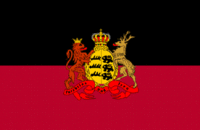Wuerttemberg
| Conventional short name: | |
| Local: | Württemberg |
| English: | Wuerttemberg |

| |
| National motto: THE MOTTO! | |
| Area: | 8,906 square miles |
| Cities: | |
| Capital: | Stuttgart |
| Largest: | Stuttgart |
| Other: | Heilbronn, Ulm, Reutlingen |
| Currency: | 1 Convention Thaler = 20 Kreuzer = 240 Pfennige |
| Established: | YEAR, DECREE OR REASON |
| Languages: | |
| Official: | German |
| Others: | OTHER LANGUAGES |
| Population: | 5,560,000 (2003) |
| RULER: | NAME |
| Organizations: | Holy Roman Empire |
Over the centuries, the Kingdom of Württemberg has changed in both size and shape. The southern part of Württemberg was at one time the core of the medieval duchy of Swabia; Württemberg north of Stuttgart was part of Franconia. While the territories were traded between the gentry as frequently as children today trade cards, Count Eberhard V in 1482 declared the family holdings to be indivisible.
In 1495, Württemberg was granted a ducal ranking, though this was short lived, as the Swabian Cities League feared the increasing power of Württemberg, and in 1519 expelled Duke Ulrich I from his domains, and the following year (1520) sold it wholesale to the new emperor Charles V.
Ulrich fought a never-ceasing battle to recover his family’s lands. Joining Protestantism, Ulrich gained the help of Philip of Hesse, a Reformation defender, and through Philip, Francis I of France. During this time, the peasantry of Württemberg rose up against the hated government of King and later Emperor Ferdinand I.
In the battle of Lauffen in 1534, Ulrich and Philip sent Ferdinand's troops running in fear, and Ferdinand was forced to return Württemberg to Ulrich, although there were stipulations that Ulrich held the duchy as a fief from Austria. Württemberg was not restored as part of the Holy Roman Empire until 1599.
Although Lutheranism was introduced with Ulrich’s return, many parts of southern Württemberg remained staunch in their worship according to Roman Rite Catholicism, and thus explain the current minority of Catholics in the Kingdom.
Württemberg has repeatedly been the theater for the Great Wars of Europe, and because of this increased in size to its modern borders. Between 1802 and 1810 the territories of Württemberg were more than doubled and reached their final frontiers after an alliance with France under Napoleon.
Modern Württemberg is currently largely focused on agriculture, producing grain, and vineyards of note. There is mining industry focused largely on iron, salt and stone. The Iron industry has only recently grown with the trade bringing in coal to help in production.
The largest export of note from Stuttgart is the car manufacturer Porsche, producing luxury sports cars and Daimler-Benz, producer of Mercedes-Benz plane engines and luxury cars.
| |||
|---|---|---|---|
| Member Entities | |||
| Anhalt | Baden | Bavaria | Bremen | Brunswick | Hamborg | Hannover | Hesse | Lippe | Luebeck | Luxemburg | Mecklenburg | Oldenburg | Premaria | Prussia | Rhineland-Palatinate | Saarland | Saxony | Schleswig-Holstein | Thuringia | Waldeck-Pyrmont | Westphalia | Wuerttemberg | |||
| Colony: Rickerman-Insel |